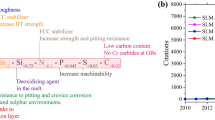Abstract
A look at high strength low alloy steels from the European viewpoint: metallurgical factors, economic constraints and future development trends
Abstract
We shall begin by defining a high strength steel as one which has a yield strength of at least 300 N/mm2 (43 ksi). In Britain, this involves structural steels made to BS4360 Grades 50 or 55 and for pressure vessels, BS1501 Grades 223 and 224. In Europe, reference should be made to Euronorm 113, Grades FeE 315, 355, 390, 420 and 460. These steels are all frequently welded and are usually supplied to restricted composition ranges to minimize the risk of hydrogen induced cold cracking. Essentially, we are talking about carbon-manganese steels with very small additions of vanadium and/or columbium for grain refinement and precipitation hardening.
Similar content being viewed by others
References
Gladman, T., Dulieu, D. and Mclvor, I. D., “Structure-Property Relationships in High-Strength Microalloyed Steels,” Microalloying 75, Session 1, 1975 p. 25.
Morrison, W. B., “The Effect of Grain Size on the Stress-Strain Relationship in Low-Carbon Steel,” Trans. ASM, Vol. 59, 1966, p. 824.
Hutchinson, M., “The Temperature Dependence of the Yield Stress of Polycrystalline Iron,” Phil Mag., Vol. 8, 1963, p. 121.
Cracknell, A., and Petch, N. J., “Frictional Forces on Dislocation Arrays at the Lower Yield Point in Iron,” Acta. Met., Vol. 3, 1955, p. 186.
Mackenzie, C. R.—British Steel Corporation—private communication.
Matsuda, S., Inoue, T., Mimura H., and Okamura, Y., “Toughness and Effective Grain Size in Heat Treated Low-Alloy High Strength Steels,” Towards Improved Ductility and Toughness, 1971, p. 45.
Morrison, W. B., Mintz, B., and Cochrane, R. C., “Structure Property Relationships in Controlled Processed Steels,” Controlled Processing of High Strength Low Alloy Steels, York 1976, p. 1/1.
Cohen, M., “Strengthening Mechanisms in Steel,” Trans. Jap. Inst. Met., Vol. 9, 1968, p. 23.
Mitchell, P. S.—British Steel Corporation—private communication.
Tamura, I., Tomota, Y., Akao, A., Yamaoka, Y., Ozawa, M., and Kanatani, S., “On the Strength and Ductility of Two-phase Iron Alloys, Trans. ISIJ Vol. 13, 1973, p. 283.
Smith, C. I.—British Steel Corporation—private communication.
Irvine, K. J., Pickering, F. B., and Gladman, T., “Grain Refined Carbon-Manganese Steels,” JISI, Vol. 205, 1967, p. 161.
Little, J. H., Chapman, J. A., Morrison, W. B., and Mintz, B., “The Production of High Strength Plate Steels by Controlled Rolling,” Third International Conference on Strength of Metals and Alloys—Cambridge, 1973, p. 80.
Preston, R. R., and Mackenzie, C. R., “A Study of a Range of High Strength As-Rolled, Plate Steels Containing Manganese and Molybdenum”—Molybdenum 1973 Conference, Copenhagen 1973, p. 107.
Brown, G. G., and MacDonald, J. K., “Steels for High Pressure Gas Transmission Pipelines,” J. Aust. Inst. Metals., Vol. 19, No. 3, 1974, p. 168.
Bergh, S., and Westerberg, G., “Fine Grained Steel—A Summary of its Mechanisms, Properties and Fields of Application,” Jernkont. Ann., Vol. 155, 1971, p. 671.
Sage, A.M., “X70 Vanadium Steel, Report on Development of Steel for Linepipe,” Vanitec, 1975.
Shummer, A., “Microalloyed Steels for Hot Rolled and Cold Formed Shapes and Concrete Reinforcing Bars,” Microalloying 75, Session 2A, 1975, p. 48.
Dolby, R. E., “Welding of Controlled Processed HSLA Steels,” Controlled Processing of HSLA Steels, York, 1976, p. 4/1.
de Boer, H., “Plates With Improved Properties in the Thickness Direction and Their Application,” Thyssen, Offshore-Technik, 1974, p. 10.
Preston, R. R., “Steels for North Sea Structures,” URS Conference, Cork, 1975.
Fukuda, M., Hashimoto, T., and Kitagawa, Y., “An Investigation of the Improvements of the Transverse Charpy Absorbed Energy of As-Rolled High Strength Steel Plates,” The Sumitomo Search, No. 14, 1975, p. 17.
Additional information
Robert R. Preston is Manager of the Rails and Sections Department of the Research Organization of the British Steel Corporation, Teesside Laboratory, Middlesbrough, England. He graduated with an honors degree in physics from Queen Mary College (University of London) and did post-graduate work at the University College of North Wales, Bangor.
Rights and permissions
About this article
Cite this article
Preston, R.R. HSLA Metallurgy in Europe. JOM 29, 9–16 (1977). https://doi.org/10.1007/BF03354298
Published:
Issue Date:
DOI: https://doi.org/10.1007/BF03354298




